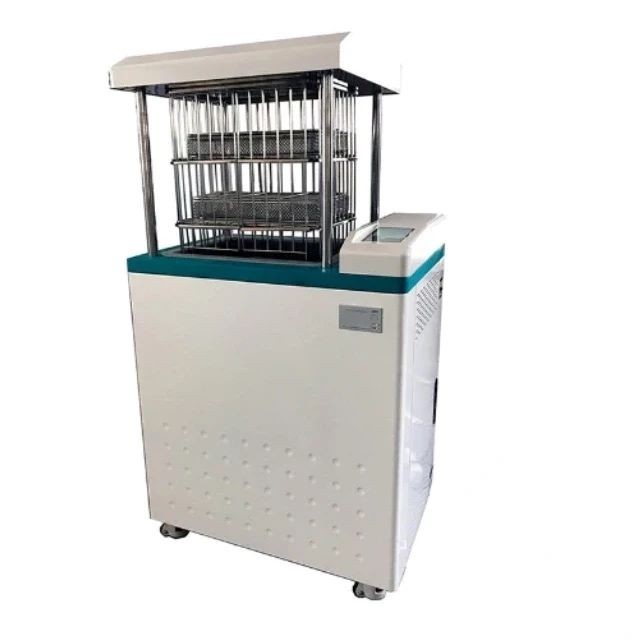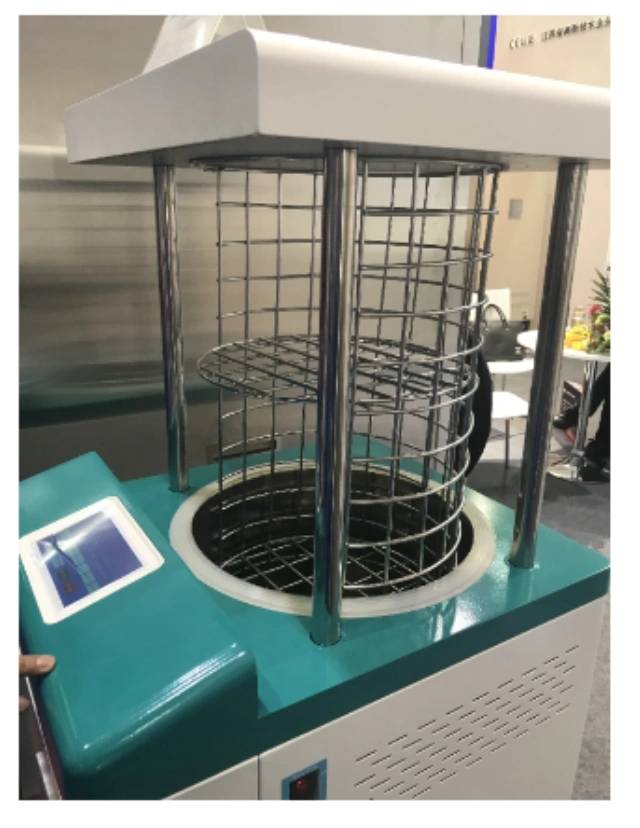
sterilization equipment
Laboratory Sterilizer Lab Autoclave Pulse Vacuum Lifting Sterilizer
Item Number : KT-Q02
Price varies based on specs and customizations
- Electric Tension
- 220V
- Material
- Stainless Steel
- Timer
- 0-99min
Shipping:
Contact us to get shipping details Enjoy On-time Dispatch Guarantee.
Why Choose Us
Reliable PartnerEasy ordering process, quality products, and dedicated support for your business success.
Introduction
- Seven-inch capacitive touch screen for easy operation.
- Vertical lifting door design reduces operator labor intensity.
- Automatic process with water filling, pulsating vacuum pumping, heating, sterilizing, draining, exhausting, and vacuum drying.
- Pulsating vacuum mode ensures thorough sterilization with a vacuum limit of -0.080Mpa.
- Independent steam generator design saves energy, minimizes damage, and reduces oxidation of sterilized items.
- Multiple fixed program modes for customized sterilization programs.
- No standard PT/TT test interface for convenient testing by the department.
- Equipped with a German Sartorius sterile air exchange filter to prevent contamination.
- Steam-water internal circulation system maintains a clean and dry environment.
Detail & Parts



Technical Parameters
| Model | KT-60SV | KT-80SV | KT-100SV | KT-120SV |
| Effective volume of sterilization chamber | 60L φ396×490mm | 80L φ396×650mm | 100L 504×404×502mm | 120L 504×404×590mm |
| Height after lifting | 1310 | 1590 | 1475 | 1565 |
| Work pressure | 0.22Mpa | |||
| Operating temperature | 134℃ | |||
| Thermal uniformity | ≤±1℃ | |||
| Timing selection range | 0-99min | |||
| Temperature selection range | 105-134℃ | |||
| Power/supply voltage | Steam generator power: 3KW Drying belt power: 2.4KW/AC220V 50HZ | Steam generator power: 3.6KW Drying belt power: 2.4KW/AC220V 50HZ | ||
| Dimensions (mm) | 686×556×913 | 686×556×1035 | 840×600×970 | 840×600×1060 |
| Transport volume (mm) | 789×656×1013 | 786×656×1135 | 940×610×1000 | 940×610×1075 |
| Gross weight/net weight | 210Kg/180Kg | 230Kg/200Kg | 300Kg/270Kg | 325Kg/295Kg |
Designed for You
KinTek provide deep custom made service and equipment to worldwide customers, our specialized teamwork and rich experienced engineers are capable to undertake the custom tailoring hardware and software equipment requirements, and help our customer to build up the exclusive and personalized equipment and solution!
Would you please drop your ideas to us, our engineers are ready for you now!
FAQ
What Is Laboratory Vacuum Pump?
What Are Some Common Applications Of Sterilization Autoclaves?
What Is The Purpose Of Vacuum Pump In Laboratory?
How Long Does A Typical Sterilization Autoclave Cycle Take?
What Is The Use Of Pump In Laboratory?
Can Autoclave Sterilization Be Validated For Effectiveness?
What Is Used In A Laboratory To Form And Contain A Vacuum?
Can Autoclave Sterilization Damage Certain Materials?
How Does A Laboratory Vacuum Pump Work?
How Should Autoclave Sterilization Be Monitored And Documented?
4.6
out of
5
This sterilizer has been a game changer for our lab. It's so much faster and more efficient than our old one.
4.7
out of
5
The vacuum function ensures thorough sterilization, even for hard-to-reach areas. Highly recommend!
4.8
out of
5
The independent steam generator design saves energy and minimizes damage to sterilized items. A great investment for our lab.
4.9
out of
5
The pulsating vacuum mode ensures thorough sterilization, leaving us confident in the safety of our instruments.
4.6
out of
5
The sterilizer's automatic process makes it easy to use, even for new lab technicians.
4.7
out of
5
The vertical lifting door design reduces operator labor intensity, making it a breeze to use.
4.8
out of
5
The multiple fixed program modes allow for customized sterilization programs, meeting the specific needs of our lab.
4.9
out of
5
The steam-water internal circulation system maintains a clean and dry environment, ensuring the longevity of our instruments.
4.6
out of
5
The seven-inch capacitive touch screen is user-friendly and easy to operate, even for those new to the lab.
4.7
out of
5
The sterilizer's compact size fits perfectly in our limited lab space, maximizing efficiency.
4.8
out of
5
The vacuum drying function speeds up the sterilization process, allowing us to process more loads in a shorter time.
4.9
out of
5
The sterilizer's durable construction ensures years of reliable operation, making it a worthwhile investment for our lab.
4.6
out of
5
The sterilizer's advanced technology ensures effective sterilization, giving us peace of mind in our lab procedures.
4.7
out of
5
The sterilizer's fast delivery and excellent customer service made the entire process smooth and hassle-free.
REQUEST A QUOTE
Our professional team will reply to you within one business day. Please feel free to contact us!
Related Products

Laboratory High Pressure Steam Sterilizer Vertical Autoclave for Lab Department
Vertical pressure steam sterilizer is a kind of sterilization equipment with automatic control, which is composed of heating system, microcomputer control system and overheating and overpressure protection system.

Laboratory High Pressure Horizontal Autoclave Steam Sterilizer for Lab Use
The horizontal autoclave steam sterilizer adopts the gravity displacement method to remove the cold air in the inner chamber, so that the inner steam and cold air content is less, and the sterilization is more reliable.

Desktop Fast Laboratory Autoclave Sterilizer 35L 50L 90L for Lab Use
The desktop fast steam sterilizer is a compact and reliable device used for rapid sterilization of medical, pharmaceutical, and research items. It efficiently sterilizes surgical instruments, glassware, medicines, and resistant materials, making it suitable for various applications.

Portable High Pressure Laboratory Autoclave Steam Sterilizer for Lab Use
Portable autoclave sterilization pressure is a device that uses pressure saturated steam to quickly and effectively sterilize items.

Laboratory Sterilizer Lab Autoclave Pulsating Vacuum Desktop Steam Sterilizer
The pulsating vacuum desktop steam sterilizer is a compact and reliable device used for rapid sterilization of medical, pharmaceutical, and research items.

Desktop Fast High Pressure Laboratory Autoclave Sterilizer 16L 24L for Lab Use
The desktop fast steam sterilizer is a compact and reliable device used for rapid sterilization of medical, pharmaceutical, and research items.

Portable Digital Display Automatic Laboratory Sterilizer Lab Autoclave for Sterilization Pressure
Portable autoclave sterilization pressure is a device that uses pressure saturated steam to quickly and effectively sterilize items.

Desktop Fast Laboratory Autoclave Sterilizer 20L 24L for Lab Use
The desktop fast steam sterilizer is a compact and reliable device used for rapid sterilization of medical, pharmaceutical, and research items.

Stainless High Pressure Autoclave Reactor Laboratory Pressure Reactor
Discover the versatility of Stainless High Pressure Reactor - a safe and reliable solution for direct and indirect heating. Built with stainless steel, it can withstand high temperatures and pressures. Learn more now.

Laboratory Sterilizer Lab Autoclave Herbal Powder Sterilization Machine for Plant
The herbal powder sterilization autoclave machine for Chinese medicine uses saturated steam for effective sterilization. It utilizes the heat and penetrative properties of steam, achieves sterilization after heat preservation, and maintains a good drying effect with a dedicated drying system.

Laboratory Horizontal Autoclave Steam Sterilizer Lab Microcomputer Sterilizer
The horizontal autoclave steam sterilizer adopts the method of gravity displacement to remove the cold air in the inner chamber, so that the content of steam cold air in the inner chamber is less, and the sterilization is more reliable.

Mini SS High Pressure Autoclave Reactor for Laboratory Use
Mini SS High Pressure Reactor - Ideal for medicine, chemical, and scientific research industries. Programmed heating temp and stirring speed, up to 22Mpa pressure.

Liquid crystal display automatic vertical sterilizer is a safe, reliable and automatic control sterilization equipment, which is composed of heating system, microcomputer control system and overheating and overvoltage protection system.

Customizable High Pressure Reactors for Advanced Scientific and Industrial Applications
This laboratory-scale high-pressure reactor is a high-performance autoclave engineered for precision and safety in demanding research and development environments.

High Pressure Laboratory Vacuum Tube Furnace Quartz Tubular Furnace
KT-PTF High Pressure Tube Furnace: Compact split tube furnace with strong positive pressure resistance. Working temp up to 1100°C and pressure up to 15Mpa. Also works under controller atmosphere or high vacuum.

Laboratory Benchtop Water Circulating Vacuum Pump for Lab Use
Need a water circulating vacuum pump for your lab or small-scale industry? Our Benchtop Water Circulating Vacuum Pump is perfect for evaporation, distillation, crystallization, and more.

Laboratory Vertical Water Circulating Vacuum Pump for Lab Use
Looking for a reliable water circulating vacuum pump for your lab or small-scale industry? Check out our Vertical Water Circulating Vacuum Pump with five taps and a larger air sucking amount, perfect for evaporation, distillation, and more.

High Pressure Laboratory Autoclave Reactor for Hydrothermal Synthesis
Discover the applications of Hydrothermal Synthesis Reactor - a small, corrosion-resistant reactor for chemical labs. Achieve rapid digestion of insoluble substances in a safe and reliable way. Learn more now.
Related Articles

The Thermodynamics of a Perfect Seal: A Component-Level Approach to Sterilization
Learn why autoclaving your entire electrolytic cell destroys the seal. A guide to understanding material properties and protecting your experiments.

How to Save Money When Buying a Rotary Evaporator (Rotavapor)
A rotary evaporator, also known as a rotavapor, is a laboratory equipment commonly used to remove solvents from a sample. It works by rotating the sample flask to create a thin film of the solvent, which is then evaporated.

Affordable Rotavapor How to Save on Your Purchase
Rotavapor is a laboratory equipment that is used for distillation, purification, and concentration of liquid samples. It is a vital tool for chemists, biologists, and other researchers who work with various types of solvents and chemicals.

Is a High-Priced Rotavapor Worth the Investment
Rotary evaporators, also known as rotavaps, are essential laboratory equipment used in the chemical, pharmaceutical, and biotech industries for the separation of solvents from a solution.

Disc / Cup Vibratory Mill: A Comprehensive Guide to Grinding Equipment
Discover the world of Disc / Cup Vibratory Mills! This guide covers everything from types and features to applications and benefits. Explore the versatility of these mills for grinding various materials in industries like pharmaceuticals, food, and chemicals.

CVD Systems Common Problems and How to Solve Them
Understanding the basics of CVD systems and their importance is crucial for optimizing the process and solving common problems encountered during operation.

How to Get the Best Deal on a Rotavapor for Your Lab
A Rotavapor is an essential laboratory equipment that is widely used in various fields such as chemistry, biology, and pharmaceuticals.

Wet Bag Isostatic Pressing and Dry Bag Isostatic Pressing: A Comparative Study
Isostatic pressing is an essential manufacturing process that is used to produce high-quality and complex parts. Two common methods of isostatic pressing are wet bag isostatic pressing and dry bag isostatic pressing.

Basic Laboratory Drying Equipment
Overview of various drying equipment used in laboratories, including vacuum, blast, electric heating, hot air disinfection, and infrared drying ovens.

Basic Cleaning and Disinfection Equipment in the Laboratory
Overview of essential lab cleaning and disinfection tools and their operational principles.

Operating Procedures for Vacuum Sintering Furnace
Detailed steps and precautions for operating a vacuum sintering furnace.

Application of Liquid Nitrogen in Food Freezing
Explores the use of liquid nitrogen in food freezing, its advantages, methods, equipment, and safety considerations.